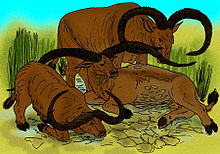Pelorovis
| Pelorovis | ||||||||||||
|---|---|---|---|---|---|---|---|---|---|---|---|---|

Skull of Pelorovis oldowayensis in the museum at the Olduvai Gorge |
||||||||||||
| Systematics | ||||||||||||
|
||||||||||||
| Scientific name | ||||||||||||
| Pelorovis | ||||||||||||
| Horizontal bar , 1925 |
Pelorovis was a large cattle genus from the Pliocene , Pleistocene, and Holocene of Africa. The genus appeared for the first time around 2.5 million years ago andprobablysurvived with Pelorovis antiquus in North Africa until around 4,000 years ago. However, recent studies have come to the conclusion that the genus is not monophyletic . The early forms ( P. turkanensis and P. oldowayensis ) are apparentlycloseto the modern genus Bos and could represent the first representatives of the real cattle. The late Pleistocene form ( Pelorovis antiquus ), on the other hand, was apparently closely related to the African buffalo ( Syncerus ), and there are serious proposalsto classifyit as Syncerus antiquus .
Appearance
Pelorovis resembled modern cattle , but the horns exceeded that of most modern species in length. They could reach spans of up to 3 meters. There are clear differences in the shape of the horn to today's species as well as between the various Pelorovis species. Pelorovis oldowayensis and Pelorovis turkanensis had horns that curved downwards, the Pelorovis antiquus somewhat reminiscent of today's water buffalo ( Bubalus ), which is why this species was originally included in the genus Bubalus .
Pelorovis oldowayensis was similar in size to today's Cape Buffalo , but due to the longer legs it came to a higher shoulder height. The elongated head, which is somewhat reminiscent of today's hartebeest , was characteristic of this species . Pelorovis antiquus was of a similar size, but overall more robustly built. The skull of this type wasn't that elongated either.
species
So far, the following species of the genus have been described:
- Pelorovis antiquus ( Duvernoy , 1851)
- Pelorovis turkanensis Harris , 1991
- Pelorovis oldowayensis horizontal bar 1928
- Pelorovis kaisensis Geraads & Thomas , 1994
- Pelorovis howelli Hadjouis & Sahnouni , 2006
distribution
Pelorovis antiquus was found in East and South Africa until 12,000 years ago. A complete skeleton of the species comes from the Djelfa area in Algeria. Fossil and archaeological findings suggest that this species lived in North Africa until about 4000 years ago.
Pelorovis oldowayensis lived in Africa south of the Sahara until around 800,000 years ago. The best preserved finds were found in the Olduvai Gorge in Tanzania.
literature
- Alan Turner, Mauricio Antón: Evolving Eden. An Illustrated Guide to the Evolution of the African Large-Mammal Fauna. Columbia University Press, New York NY 2004, ISBN 0-231-11944-5 .
- Ronald M. Nowak: Walker's Mammals of the World. 6th edition. Johns Hopkins University Press, Baltimore MD et al. 1999, ISBN 0-8018-5789-9 .
Web links
- Darren Naish: The 'Great bubalus' in ancient African rock art. In: scienceblogs.com. ScienceBlogs , April 28, 2011, accessed September 2, 2017 .
Individual evidence
- ↑ Bienvenido Martínez-Navarro, Juan Antonio Pérez-Claros, Maria Rita Palombo, Lorenzo Rook, Paul Palmqvist: The Olduvai buffalo Pelorovis and the origin of Bos. In: Quaternary Research. 68, 2007, p. 220, doi : 10.1016 / j.yqres.2007.06.002 .
- ^ Richard G. Klein: The Long-Horned African Buffalo (Pelorovis antiquus) is an Extinct Species . In: Journal of Archaeological Science . tape 21 , 1994, p. 725-733 ( online at ResearchGate ).

